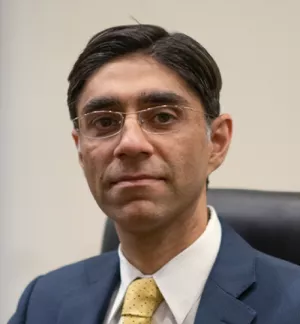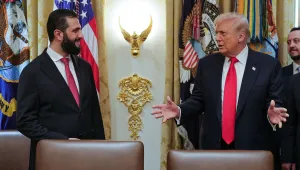Where do India and Pakistan stand today, and can the immediate crisis be considered resolved?
The crisis is officially over, in as much as there is a ceasefire that the U.S. brokered and India and Pakistan have accepted.
There have been conversations between senior Indian and Pakistani military officials and they are working according to a plan to de-alert their respective militaries by the end of May.
That said, the situation remains very murky because there is still a continuing conversation about whether this is just a pause, or if we are on the way to the status quo as it existed before the crisis. The situation between the two countries typically remains tense, especially on the Line of Control (LoC) in the disputed territory of Kashmir, although recent years has seen relative calm courtesy of a February 2021 LoC ceasefire that has mostly held. An immediate return to the same would be welcome.
Indian signaling is mixed, perhaps deliberately as part of it seems aimed at pacifying a highly charged domestic environment. Prime Minister Modi's speech to India on May 12, 2025, after the cessation of major hostilities, was jingoistic. Indian Defense Minister Rajnath Singh made matters worse shortly thereafter by stating that “Operation Sindoor is not over yet. Whatever happened was just a trailer. When the right times comes, we will show the full picture to the world,” when addressing Indian Airforce personnel at an airbase. No such escalatory statement was issued by Pakistani officials.
How has the U.S. handling of the situation changed from past interventions between India and Pakistan?
The U.S. must get credit for bringing this crisis to an end just when it was poised for further escalation.
The U.S. role was peculiar only because it deviated slightly from the well-established crisis diplomacy playbook in South Asia. India-Pakistan crises have always been de-escalated through third party involvement, with the U.S. playing the most prominent role.
This time, the initial period saw the U.S. being somewhat hands-off. President Trump clearly signaled that he wanted India and Pakistan to find a way out themselves. Vice President Vance echoed this in even starker terms a few days later by saying: “What we can do is try to encourage these folks to de-escalate a little bit, but we’re not going to get involved in the middle of war that’s fundamentally none of our business and has nothing to do with America’s ability to control it.”
All this changed abruptly once it became clear that India had chosen to break past taboos and launch a multipronged drone and missile attack deep inside Pakistan, and Pakistan responded in kind. It seems that India reached out to Washington and this coincided with the U.S. picking up ‘alarming intelligence’ suggesting imminent escalation. The old playbook returned immediately, with the U.S. leading a frenzy of diplomacy and leaning on regional countries to reinforce its message. Within hours, the U.S. had convinced both sides to back off and terminate active hostilities. President Trump has since claimed that his team’s intervention prevented nuclear war in South Asia.
What are the key lessons from this crisis?
Any use of force in a nuclear environment, especially in South Asia where the nuclear powers are neighbors, is going to bring in excessive risks of escalation into the equation. Once the first shot is fired, it is impossible to tell how the crisis will progress. It's as much good fortune as it is strategy that ultimately helps such crises come to an end. And that's always going to be the case.
The answer lies in working to prevent crises from occurring in the first place. This requires robust crisis prevention and dispute resolution mechanisms between India and Pakistan, helped by the third parties if needed. The inability to ensure this has been the real failure in South Asia.
How confident are you that a similar escalation between India and Pakistan will not be repeated?
Not at all. And that's because every single crisis in South Asia has made the next one more dangerous and more unpredictable. This time a number of taboos have been broken. India has unilaterally suspended the Indus Water Treaty, which is the only water division treaty through which Pakistan gets overwhelming majority of its water that feeds 250 million people. Weaponizing water at this scale in a nuclear environment is unprecedented – and unfortunate to say the least. Pakistan has already said it will consider any Indian action to stop water flows as an act of war. Moreover, in the past, most of the use of force between the two sides was limited to the Kashmir. India crossed the international border for the first time in the last crisis in 2019, but this time the scale of the attack was unprecedented, as was Pakistan’s response. These are all escalatory developments and there will be pressure to go further next time.
I also get the sense that India hasn’t left the crisis fully satisfied. The domestic discussion in India suggests they see it as an unfinished business since didn’t end up where they had hoped. In Pakistan, there is belief now that responding to India in a tit-for-tat manner is the only way to deter the adversary. This combination makes for an extremely dangerous crisis next time round, and dare I say, it may come sooner than any of us would expect.
How do you see Indo-Pakistan tensions impacting U.S. interests in the region?
Absolute disaster for the U.S. The longer India and Pakistan remain enemies, the worse it is for the United States. In fact, I would go to the extent of saying that the U.S. risks losing South Asia if India-Pakistan tensions continue.
India has been chosen as the principal strategic partner in South Asia to counter China. While I don’t think this is well thought out, if that is the goal, then for India to have any chance of being a regional power, it has to be fully and unequivocally concentrated on this goal alone without distractions. The more India is entangled with Pakistan, the less likely it will be to perform that role.
India’s post-crisis posture makes things worse for the U.S. India is claiming to have created a ‘new normal’ with Pakistan. Prime Minister Modi has said that from now on, India will be the judge, jury and executioner and respond by waging war against Pakistan if there is any terrorist attack. If so, Pakistan could do the same given its accusations of Indian involvement in terrorism in Pakistan’s western province of Balochistan. The two countries will perpetually be at the brink of war, and India (and Pakistan) constantly distracted.
Moreover, the more aggressive India’s posturing, the more vulnerable Pakistan will feel. This will force Pakistan even closer to China against India, further cementing an already strategic partnership. Nothing could be more self-defeating for India – and the U.S. For India, one of its nightmare scenarios for long has been a joint China-Pakistan front against it. China has made it clear in the recent crisis that it will stand by Pakistan in any conflict, and this will strengthen its position further.
For the U.S., despite its unease with Pakistan’s proximity to China, it is not a country it wants to write off. President Trump has reiterated his interest in maintaining a good relationship with Pakistan. Pakistan too has been signaling for years that it wants to maintain good relations with both U.S. and China and formally espouses a ‘no camp politics’ foreign policy. Any development that forces Pakistan to lean too far in the other direction won’t suit America’s interests.
And finally, leaving everything aside, how can the world’s only superpower ever be comfortable with a situation where two nuclear powers are always one incident away from getting into a full-fledged conflict?
What is the way forward for India and Pakistan?
Talk, talk, talk.
Let us first be clear about one thing: India and Pakistan cannot stop being neighbors. And they cannot fight and win a war without risking mutual annihilation. Anyone thinking otherwise is not of a sane mind.
I'm somebody who's advocated improved relations between India and Pakistan in my scholarship for years. And even as a Pakistan official, my take was that we should find a way to live like civilized neighbors. But I have to say I have been forced to change my view for now. The current Indian government believes it is too strong and too desirable for the world to be affording Pakistan an adult conversation. They have shunned all dialogue, tying it to their claim of Pakistan’s support for terrorism in India. The problem is that Pakistan accuses India of the same, and much more. Regardless of the merits of these tit-for-tat accusations, holding on to these positions is a dead end.
At least I don’t know anyone who has been able to offer an alternative to sitting down and talking through each and every problem India and Pakistan have if there is to be any hope of improving ties and avoiding being on the brink of nuclear war every so often. President Trump has been alluding to the same as he has advocated dialogue and offered U.S. help in recent days. I hope he succeeds because at the end of the day, this isn’t about two states. The lives of 2 billion South Asians are at stake. South Asia remains one of the poorest regions and is also the least economically integrated region in the world. People in the region deserve better.
I must warn you though that this is going to be a heavy lift. India has constantly rejected dialogue and the current Pakistani civil and military leadership feel India has seen Pakistan’s offers of talks as a sign of weakness. I don’t see them going out of the way to get going either.



